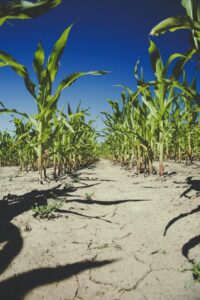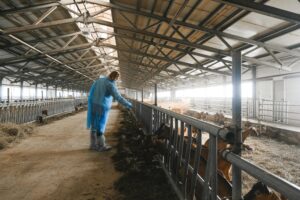
Farmers advised to implement weather wise measures
The department advised farmers in regions that are in a reasonable condition to prepare in line with the expected conditions, but also issued warnings.
Christian Giesel, Head of Marketing for Syngenta South Africa, the headline sponsor of the Syngenta Boerekos Plaaskombuis, explains. “We are very clear about the fact that the entire food-production value chain is focused on what ends up on consumers’ plates. Syngenta wants to showcase how sustainable food production can be achieved with the use of leading technologies to create more from less. Part of Syngenta’s sustainability goals is to ensure that every person on earth has enough safe, quality food to eat. To achieve this, every link in the value chain has to function optimally and responsibly.”
The Plaaskombuis restaurant was meant to demonstrate the importance of food in society by bringing the farm-to-plate concept to life. It did so admirably, by serving restaurant-style food prepared with with quality ingredients, including some of the latest vegetable varieties that Syngenta has produced with local farmers. Add to this mix renowned Boerekos chef Arina du Plessis and you were set to experience a wonderful fusion take on traditional favourites, such as pork ragu on maize nacho chips, dressed with tomato salsa, cheese, avo, fresh coriander, sour cream and a sweet chili sauce.
“The objective behind the concept was to promote sustainable and responsible food production by showcasing the variety that well-known ingredients are capable of delivering,” notes Giesel. “We don’t have to import exotic ingredients at great cost to the environment and household budgets. Instead, the focus should be on local production and consumption patterns that strike a balance between resource conservation, optimal yield and equitable access through cutting edge agriculture technologies.”
In Africa, the importance of farm-to-plate cannot be overstated. According to the Statista.com website, Africa’s total population would likely reach nearly 2.5 billion by 2050 – almost double the 2023 figure. It is a staggering number of bellies to keep full, every day of the year, a task that is only achievable when the food-production and -supply systems function optimally and sustainably.
“Feeding the ever-growing global population requires large-scale, commercial farming,” says Giesel, “and we have to keep improving methods across all sectors of our agricultural systems.” Tremendous advances have been made over the years. For instance, since the 1950s, there has been a 95% decrease in the average application rate of active ingredients per hectare. At the same time, crop yields have more than tripled thanks to wide-ranging innovation, including improvements in plant breeding. These measures to make everyone’s food safer have been reinforced with the Codex Alimentarius, the open, transparent system of international standards established in 1963 to protect consumer health and promote fair practice in the food trade.
But there is another side to the coin: in South Africa, it is estimated that only 15% to 20% of commercial farmers and 5% of smallholder grain farmers have adopted conservation tillage practices (Bürgener (2021), mg.co.za, Embracing the Farm to Fork philosophy) which mitigate the impacts of intensive farming and are a bulwark against the increasingly disruptive impact of climate change on weather patterns. Healthy soil, for instance, can better tolerate flooding, which safeguards crop yield and helps to keep food inflation and its harmful impact on food security at bay.
Giesel points out that Syngenta is concerned with both food security and food safety. “Bringing new solutions to market to control pests and diseases in South Africa remains our key concern. Resistance and sensitivity shifts by pests and diseases to older crop protection technologies threaten the livelihoods of our growers and put our food security at risk. Worldwide, weed competition is responsible for approximately 34% of all crop losses, while insects and diseases account for losses of 18% and 16% respectively. Around 68% of annual losses can therefore be addressed through programmes that protect crops. Imagine the impact on food security if the same effort and inputs yielded almost 70% more food! And this is Syngenta’s goal with its cutting-edge research: newer, even safer solutions that do not jeopardise quality food production.”
In terms of food safety, Syngenta knows that a safe food supply starts with sound agricultural practices. These include protecting crops from being contaminated by pathogenic microorganisms and toxins and using crop-protection products that do not harm humans, animals and the environment. “An agrochemical should only target the pest it is intended to control and must be applied sparingly,” notes Giesel. “A significant number of today’s crop protection products are obtained from natural sources and have been so thoroughly tested by the time that they are introduced to market that they are very useful in integrated pest management systems.”
And this brings us full circle to the Syngenta Boerekos Plaaskombuis at NAMPO 2024. The sponsorship is a subtle reminder of the role safe and responsible crop protection plays in the quest for food safety and global food security. More overtly, it demonstrates the imperative for role players from across the food value chain to collaborate in the establishment of production, distribution and consumption systems that are sustainable and capable of meeting the nutritional needs of every person on the planet.
“Strategic partnerships with government decision-makers, growers, retailers or consumers are the key to sustainable and responsible food production. By working together we can, quite literally, change the world through food production,” concludes Giesel.
Photo by Cooker King on Unsplash

The department advised farmers in regions that are in a reasonable condition to prepare in line with the expected conditions, but also issued warnings.

The successful path to the export markets involves addressing the biosecurity challenges.

The Endangered Wildlife Trust (EWT) is working with traditional healers, traders, harvesters, and other growers to expand the diversity and volumes of species for cultivation